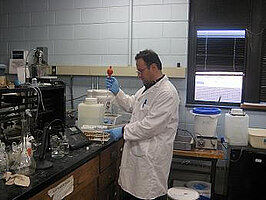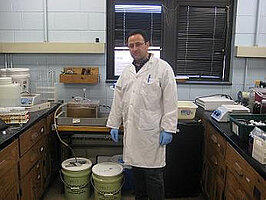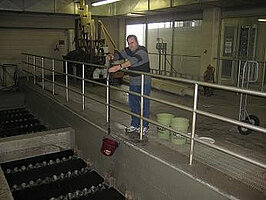Fate of Biodegradable Dissolved Organic Nitrogen in Fargo Wastewater

Halis Simsek is originally from Konya, Turkey. He received a B.S. degree in Environmental Engineering from Selcuk University in Konya, Turkey. After that he received an M.S. degree in Environmental Engineering from Gebze Institute of Technology, Gebze, Turkey. His MS research entitled “Cyanide Treatment by Ion Exchange Resin.” Later on he moved to Indiana, USA and got another MS degree in Agricultural & Biological Engineering from Purdue University. He studied remote sensing, GIS (Geographic Information System) and large scale hydrological modeling. Halis Simsek is currently working on his Ph.D. in Civil Engineering at North Dakota State University.
Email: halis.simsek@ndsu.edu
Fellow: Halis Simsek
Advisor: Eakalak Khan, Ph.D., P.E., Department of Civil Engineering, North Dakota State University, Fargo, North Dakota
Matching Support: North Dakota State University
Degree Progress: Ph.D. expected in 2010
Fate of Biodegradable Dissolved Organic Nitrogen in Fargo Wastewater
Description of the project:
The research project focuses on determining biodegradable dissolved organic nitrogen (BDON) in effluent from the Fargo Wastewater Treatment Plant (WWTP). To determine BDON, measurements of total dissolved nitrogen (TDN), dissolved ammonia nitrogen (DNH3-N), dissolved nitrite nitrogen (DNO2-N), and dissolved nitrate nitrogen (DNO3-N) are required before and after incubation. These measurements are based on dissolved constituents and therefore filtration of wastewater samples is needed.
Dissolved organic nitrogen (DON) usually represents a significant portion of nitrogen in the final effluent of wastewater treatment plants. The biodegradability of effluent DON is an important issue because biodegradable DON (BDON) can support algal growth and/or consume dissolved oxygen. As a result, several wastewater treatment plants in the United States recently have started to measure BDON in the final effluent in order to quantify how much of their effluent DON can potentially contribute to eutrophication and oxygen depletion in receiving waters.
Description of the Critical State or Regional Water Problem to be Investigated:
The Fargo Wastewater Treatment Plant (WWTP) in Fargo, ND currently treats fifteen million gallons of wastewater per day which relies mainly on a tricking filter process for treating wastewater. The peak pumping capacity of the treatment plant is twenty nine million gallons per day. The plant employs two sets of trickling filters in series. The first set of trickling filters, known as biochemical oxygen demand (BOD) filters, treats mainly carbonaceous BOD materials and reduces ammonia nitrogen (NH3-N) concentration slightly through the microbial uptake as a nitrogen source. The second set of trickling filters converts NH3-N to nitrate nitrogen (NO3-N) through biological nitrification to accommodate the minimal NH3-N removal in the BOD trickling filters. The Fargo WWTP is subjected to a NH3-N discharge limit. The fate of BDON through the Fargo WWTP has not been investigated. In addition, there has been no report on effluent BDON from BOD and nitrification trickling filters since the process is less common in wastewater utilities. Although the Fargo WWTP is currently subjected to only a NH3-N discharge limit, it is possible that the plant will be regulated on other N species or TN in the near future due to the more demanding regulation trend. Limiting effluent BDON will be crucial to meet the future discharge permit and to improve the quality of the Red River.
Project Objective:
The main scope of this study is to collect BDON data along the treatment train of the Fargo WWTP in order to achieve the following objectives:
- To evaluate the eutrophication and oxygen depletion potentials of the Fargo WWTP effluent based on BDON content and photodegradability; and
- To examine BDON removal efficiency of different treatment units in the Fargo WWTP.
Significance of Research:
This research will greatly benefit the Fargo WWTP and the quality of the Red River. Eventually, the Fargo WWTP will be subjected to a more stringent regulation on N discharge permit. This research will provide the data that the plant can use for operational changes and process upgrade to meet the future regulation. For the first time, the potential impacts of N discharge from the Fargo WWTP on the quality of the Red River will be evaluated. Quantifying effluent BDON is the first step necessary for reducing its impacts on the Red River. The findings of this project will be presented at a national or regional conference and will be submitted for publication in a peer review journal. A final report containing all the information on the project including raw data will be delivered at the end of the project.
Progress:
From March 1, 2009 to August 9, 2009, efforts were put on analytical procedure trainings and practices. The BDON determination is based on DON reduction during a 28 day incubation period. Four measurements of different dissolved nitrogen species including total dissolved nitrogen (TDN), dissolved NH 3-N (DNH 3-N), dissolved nitrite nitrogen, and dissolved DNO 3- N (DNO 3-N) are required to determine DON. The first set of samples from the Fargo WWTP was collected on August 10, 2009. Since then, the samples have been collected weekly as opposed to bi-weekly as originally proposed in order to obtain more data and to see whether there is a weekly variation in the sample characteristics. TDN was reduced by the BOD and nitrification trickling filters because of biological nitrogen uptake for cell synthesis. The reduction in DNH 3-N by the trickling filters was also observed. As expected, the trickling nitrified DNH 3-N to DNO 3-N almost completely. The DON profile along the treatment train exhibits the same general trend as the TDN profile. The effluent DON concentration was in a medium to high range before dechlorination. In several occasions, DON increase after dechlorination was observed. This interesting phenomenon has not been observed in previous studies. Sulfur dioxide used for dechlorination could be the cause of the DON increase. More data collection and a further investigation on this matter will be performed. Unlike the other nitrogen species profiles, BDON fluctuated tremendously along the treatment train. Effluent BDON was lower or comparable to influent BDON. To explain the fluctuation of BDON, more data collection is needed. For future work, more samples will be collected from the Fargo WWTP until August 2010 to obtain the nitrogen species profiles particularly for BDON all year round. This will elucidate the effect of season on the nitrogen species profiles. Seasonal changes of the nitrogen species profiles are expected because of high variations in temperature among different seasons in Fargo. From September 2010 to December 2010, effect of light on BDON experiment will be conducted to evaluate the eutrophication and oxygen depletion potentials of effluent BDON from the Fargo WWTP. Also, this time frame will be used for data analysis and to prepare a final report and publications which will include recommendations to the Fargo WWTP on how to reduce effluent DON and BDON concentrations and their eutrophication and oxygen depletion potentials which in turn would benefit the quality of the Red River. A good working relationship including data sharing with the Fargo WWTP treatment has been established and the plant highly values the proposed research




Eakalak Khan
Civil & Environmental Engineering
NDSU


